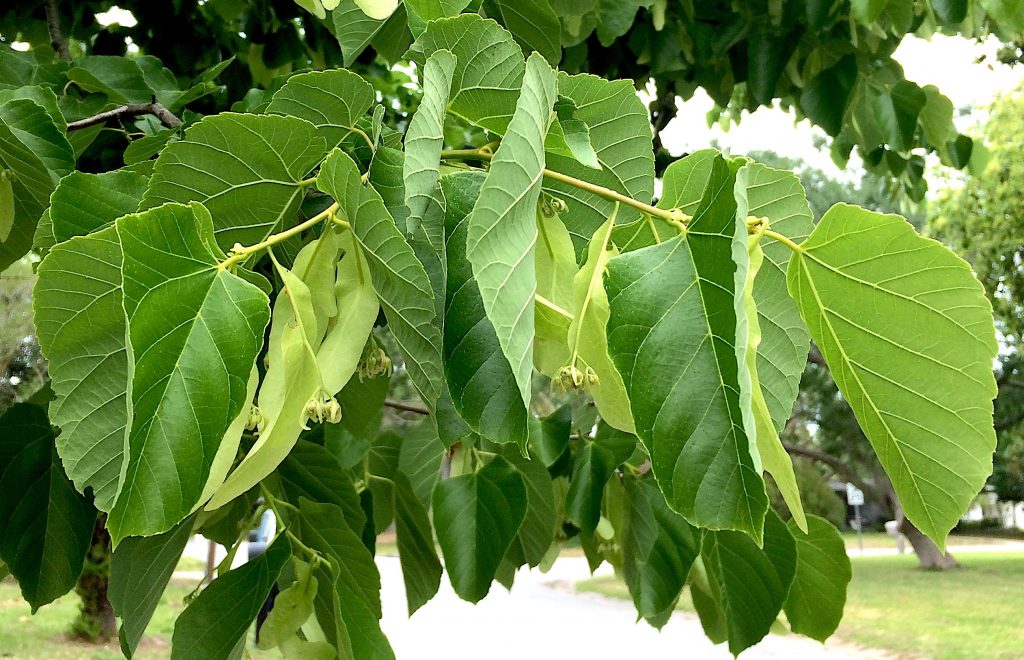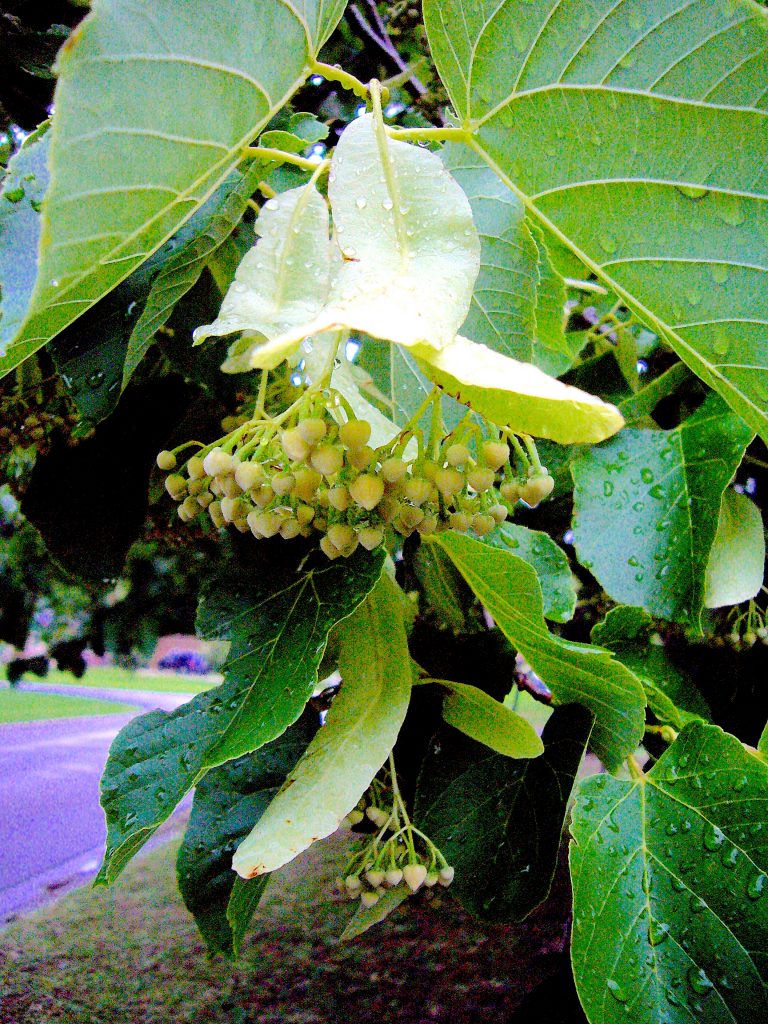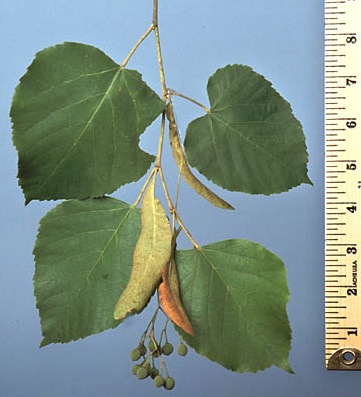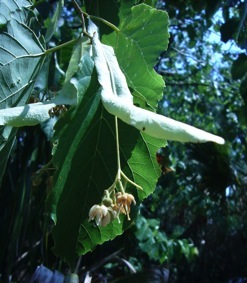
Tilia americana: Forest Fast Food
My first recollection of basswood was not on the supper table but rather helping my step-father make pipes.

First we’d find a nice piece of applewood for the bowl; take the bark off then boil the bowl wood for a couple of hours on (of all things) the wood stove. That “drove” the sap out so when it dried or was used it wouldn’t crack. After the bowl was shaped, sanded and drilled a stem was needed. That’s when we’d go find a basswood sapling of just the right size to make a stem. At that young age it’s easy to run a wire through the core and ream out the pith. That was fitted to the bowl and the pipe was done except for polishing. Dad would rub the sides of his nose with the finished bowl to give it a shine. Oil glands on our nose apparently are perfect for that. I still have one or two of those pipes we made from some 60 years ago.

It was not unusual that we turned to the Basswood for utilitarian uses rather than food. Even among the native Indians only one tribe — the Ojibwa — was known to eat parts of the Basswood. Others may have but there is no record of it. Indeed, modern foragers may actually consume more of the tree than the Natives did. However, the tree was a major source of fiber for the Indians and that’s where the common name, Basswood, comes from.“Bass” is a corruption of “bast” which is a type of fiber. The Indians soaked the bark for two to four weeks to loosen long fibers. They used the fibers for many of their needs: Bags, baskets, belts, fishnets, house mats, snowshoe netting, ropes, sewing thread and even suturing wounds. It was used where a lot of fiber strength was not needed. The Ojibwa ate the young buds raw or cooked as greens and they used the sweet sap, boiling it down to a syrup. Fortunately, there is more to be had.
Besides the buds the young leaves are a prime “wild green” of the forest. Young shiny shoots are also tasty. Edible raw or cooked you can make a salad using the leaves as the main ingredient like lettuce. Cooked they lose flavor and shrink in size considerably. The cambium, between the outer bark and the wood, in spring time, is moist and tastes of cucumber. It’s good for soups or when dried can be powdered and used for bread. You can also eat it raw off the tree, the least amount of work for the nutrition and flavor. However, don’t destroy the tree for it. Take vertical pieces.
While the flowers are edible raw or cooked and a tea can be made from them. Two tablespoons per cup. They also produce a lot of nectar creating high-quality honey. For that Basswood is sometimes called the “Bee Tree.” The tree also has a small nut, more like a seed. Fill one pocket with them as you wander through the woods, crack ’em with your teeth and spit out the shell. The tree can produce seeds when as young as eight years and continue to 100. Past 120 years old the tree starts to get a lot of “cavities” and becomes home to a many woodland creatures, notably porcupines and raccoons. Basswoods can live up to about 200 years old.
As you would guess, denizens of the forest like the Basswood as well. Whitetail deer, rabbits, mice, voles, squirrels, chipmunks and foxes snack on the tree, as do many species of song and game birds including quail. Some voles, however, girdle the tree, killing it.
One particular habit of the Basswood is to produce sprouts, especially after the main tree dies. Often you will find a clump of basswood sprouts of varying sizes, many of which get large enough to harvest. Basswood is valued for its wood which is soft, light and easily worked wood, particularly for turned items and hand carving. Natives made face masks out of it. Before synthetics it was was the material of choice for prosthetic limbs. It’s also been used to make boxes, toys, woodenware, drawing boards, veneer, venetian blinds, plywood and pulp. The Iroquois even used the bark as an emergency bandage for wounds.
One problem with the Basswood is what to call it. It has multiple common and scientific names. Experts can’t agree if there is one species with variations or several species, though they are all edible. While some call the Basswood that grows in Florida Tilia floridana (TILL-ee-uh flo-re-DANE-nah) the current name de jour is Tilia americana (a-mair-ee-KAY-na) . Tilia comes from the Greek word “ptilon” meaning wing, referring to the large winglike bracts of the flower cluster. Some think they look more like tongues than wings. Americana means of America and floridana of Florida. As for common names, particularly in Europe, the Basswood is called the Linden tree. That name comes from the Old English word of “linde.” It’s been called that for some 1300 years. So, where did “linde” come from? That’s a bit more … sticky.
Folks of yore somehow noticed that when a bird “deposits” a mistletoe seed the seed sticks to the tree. That is how mistletoe, a parasite, gets from tree to tree. So they used mistletoe (or holly) to make a glue to put on tree limbs to catch small birds. That was called birdlime, lime coming from the Latin word for mud, limus, so less poetically, bird mud. So limus became lime which became lime+en which became by 700 AD linde which then became linden. Many Brits today call the Basswood the lime tree. (The citrus “lime” came from the Arabic limah.) Lime, in the sense of mud, is still with us today. When we mark a field for sports it is called liming the field.
Personally, I like the young leaves right off the tree when they are about the size of your thumb nail. On one hike through Spring Hammock in Seminole County a Basswood tree had toppled over. Not uncommon in Florida. Weeks earlier it was upright. But this was prime leafing out season and though toppled it was putting on leaves and I ate my fill. Mild, slightly sweet, tender. Well worth looking for. And one more thing: A paste made from the seeds and flowers of the Basswood tree is a good substitute for chocolate.
Green Deane’s “Itemized” Plant Profile
IDENTIFICATION:
Tall tree to 100 feet, round uniform crown. Leaves alternating, distinctly heart shaped and strongly toothed. Creamy, five-petaled flowers in small clusters,. unique tongue-like light-colored bract with each flower cluster. No other tree in North America has such an arrangement. Gray bark, furrowed with flat ridges.
TIME OF YEAR:
Spring in Florida, early or mid summer farther north.
ENVIRONMENT:
Deep, well-drained soil. In Florida that is close to fresh water, lakes and streams
METHOD OF PREPARATION
Season new young leaves, smaller than mature leaves, lighter in color and shiny. Raw or cooked. Young shiny shoots, raw or cooked. The buds raw or cooked, a bit mucilaginous. Cambium raw or cooked, seeds raw or cooked though usually eaten raw on the trail. Sap boiled down to sugar.



